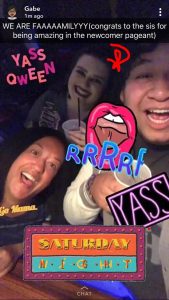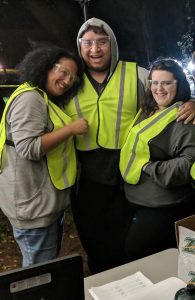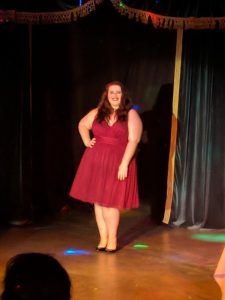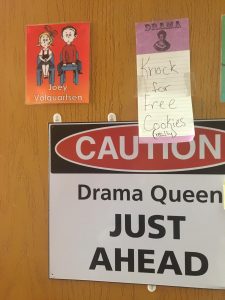Miss Sioux City Newcomer 2018 – Story #2 Final Draft
Entering the competition was an extremely last minute decision. I was prepared to make a fool of myself but I felt like this was something I had to do. I had to defend my style of performance. I had to represent for the Bio Queens.
I perform as a Bio Queen at El Patron night club in Sioux City. I have been doing shows at this bar as a back-up dancer for about three years now. In April of this year I made the jump to performing solo cementing my position as “Sioux City’s Premiere Bio Queen.” Because I am a new queen and am trying to get my name out in the community more, I decided to enter the club’s amateur drag pageant, Miss Sioux City Newcomer.
I arrived at the El Patron at 7:30 PM. The show runner had asked us to be there by 8 but the bar owner said to be there at 7. I decided to split the difference. Even though the doors opened at 7 the only person there who wasn’t a performer was the owner. He gave me a nod as I brushed past the tables toward the “backstage” area.
I have performed in this bar a million times in the past three years, but for the contest the set up was different. There was a table with a lamp and a white table cloth positioned in front of the stage where the judges would sit.
When I reached the dressing room I noticed that the dressing rooms were divided in to contestant and non-contestant performers. I took a space in the contestants’ dressing room. I decided I would take a space next to a standing mirror, without any counter space because I mostly got ready at home.
Only three of the six other performers had arrived. They were all in varying states of ready, each working with intense concentration on their contour or their eyebrows. I only had met one of them before. One of them didn’t speak English. It was going to be a long, silent night.
I had a couple finishing touches to add to my makeup “lewk” for the night. I took out my makeup bag and balanced it on the top shelf of a clothing rack. I grabbed my eyebrow pencil and darkened my eyebrows to match my hair. I drew on an eyeliner wing sharp enough to cut a bitch. Finally, I added a dark maroon lip. I checked the clock. It was only 8:00. We weren’t starting until 9.
I took my headphones out and started going over my number. I had decided to perform “Judas” by Lady Gaga. It was a high energy number with a relatively simple costume that could show off my distinct brand of slutty diva realness.
Because I decided to enter this pageant so late I only had a week to put my number together. Some of these girls had been preparing for this pageant for months. One girl even told me she designed and custom ordered her outfits from Puerto Rico. I was wearing a three dollar bralette from Walmart that I stoned, a cape I bought at Target, and a pair of leggings I had stained while painting in the scene shop that day. I started feeling very out of my league.

My Lady Gaga look for my performance of “Judas”
As time went on the room filled with the rest of the contestants. I was feeling so overwhelmed and nervous that I didn’t move from my corner of the room. The other queens started to take notice. One girl who had not performed in drag until that night, Robbie Evans, turned to me. “How long have you been performing?” “Solo? Since April. But I have been doing shows here for about three years.” “Yeah! She’s was a backup dancer!” answered Betty Jett, the only queen competing that night who I had worked with before.
I started drag the summer after my freshman year in college. I was in a musical with a lot of people I had worked with before, so I was more comfortable than I normally am in a theatre setting. I was dancing backstage with two of my new friends, Gabe and Mimi, and I caught the attention of Kathy Banta. She was putting together a drag show and was in need of another dancer. I jumped at the opportunity to perform. It was one of the best decisions I have ever made.
Since then I have done about three shows a year until April when I was formally invited to join the drag house founded by Gabe, Mimi, and Kathy called the “House of Qui”. Since starting my solo career I have performed in at least one show a month.

Two other members of the House of Qui: Mama (Kathy) and Gigi Bon Qui Qui (Gabe)
There are a couple of drag houses in the Sioux City area. We have my house, the “House of Qui”, the “Shakers,” and the “Stahrs.” These are the three most prominent that I have worked with.
A drag house is group of performers that treat each other like family. My drag mother, Kathy, helps our family by supplying costumes, helping make mixes, helping pick numbers, booking us for her shows, and keeping us professional. Kathy has said before that our house isn’t one that “set’s out to add members or build an empire.” We were just a core group of theatre people that happened to be doing all of these shows and worked together extremely well.
This sense of family also continues outside of a drag setting too. My family has supported me in my theatrical endeavors as well. The last two shows I was in they came to watch and brought me flowers. We also have family dinners on occasion where we hang out and talk about anything and everything. Just recently we went on a zombie hunt as a family outing and live streamed the whole thing to Facebook.

House of Qui at the Zombie Hunt
Our wrangler for the night, Gabby Valentino, came in to our dressing room at 8:45. By this point all of us were frantically putting on our finishing touches because we were assured we were going to start on time. She then gave us the word that we were pushing our start time back to 9:45. We all relaxed, but just barely.
The dressing room at this point was insanely crowded. It’s only about the size of a large closet. There is a counter with large mirrors on one side. On the opposite wall, a clothing rack with a shelf above it and a stand mirror beneath it. On the wall beside the door there are two small cared tables with mirrors behind them.
There were seven drag queens with all of their costumes and makeup. Four of the girls had dressers who were also in the room. One girl had a pair of backup dancers who were also in the room. It was claustrophobic.
“I love your bra!” another queen, Vanessa Divine, said. I didn’t realize this compliment was for me at first. I then realized I was the only half naked person in the room. Of course, that was my costume. “I guess it’s not a bra, what do you call that?” “Thank you!” I said, “It’s a bralette. I designed it myself!”
Her dresser, a trans woman who made sure you knew she was a trans woman, turned around sharply. “Are you competing tonight?” She asked this in a pointed tone, so much so that it made the room go quiet so I knew I wasn’t imagining it.
“Yes I am.” I answered in a weak voice. I was already nervous as it was and now I was getting questioned about something I was already insecure about. My validity as a contestant in this pageant. “Are you not, like, actually a woman?”
The concept of a Bio Queen is one that not a lot of people understand because it is not as “mainstream” as traditional drag.
Drag has grown in popularity recently with the success of the reality TV competition RuPaul’s Drag Race. However, because of that show there is a clear idea society has of what makes a drag queen. Drag Race,however, only represents one type of drag. In recent years it has even garnered criticism within the world of drag for only rewarding one facet of traditional drag and not showing more sides of the stereotypical female impersonation. Drag can be interpreted in many different ways and there are many types of performers.
A Bio Queen is a female who performs as a female impersonator. There are a number of different names that could describe the same type of performer but in Sioux City we use Bio Queen.
“Well, they let me enter,” I said to the woman. “Okay.” She offered me her hand to shake. “Stephanie Osiris, nice to meet you.” “Nice to meet you I am Joey.” I said back. “Joey what?” “Joey Volquartsen. Well Josephine De La Qui onstage.”
This response caught her off guard. “Alright, I can get in to it,” she said. “Miss De La Qui, if I have time I’m gonna watch what you do.”
I had won over my first person of the night. Hopefully the judges would be as easily swayed by the fact that I can hold my own against the sassy queens.
As this conversation was finishing up our MC for the night, Adania St. James, came in to inform us we were ready to begin. I put on my red bandana and my cape and waited for my turn to perform in the talent round.
I was contestant number five so when the fourth girl took the stage I was informed that I could stand at the side of the stage. I went to the wings and started to get in the zone.
The stage at El Patron is a raised platform near the back of the bar, the back half of which is concealed by a few hanging curtains. When the lights are on the curtains you can see through to watch the performer before you. I watched the number this queen was performing and I realized how much talent there is in the Sioux City drag community. And I was one of them. It was then I realized that I was not out of my league. The coordinators of this show could have kept me out on a technicality if they didn’t think I could hold my own. I was ready to take the stage.
As I came to this conclusion I suddenly felt a set of acrylic nails run up my arm. This startled me more than I would like to admit. I must have jumped out of my skin as Adania started laughing, really hard, and put her arms up as she walked past me to go on the stage to announce me. “Esteemed panel of judges, we present contestant number five: Josephine De La Qui!” My music started and I took the stage.
Josephine and Joey are not the same person. I barely recognize myself when I see videos of my performance. Josephine is a character I play, just as I play any of my theatre characters and I can bring her out and turn her off in a matter of seconds. In the areas where Joey is insecure Josephine could care less.
To me drag is an extension of the persona I put on for theatre. Josephine is a racy diva who doesn’t give a $#*! if you like her or not. She, much like me, wears all black but instead of yoga pants and long shirts she wears crop tops, mesh, and corsets. Josephine wears spiked heel boots or no shoes at all in order to do jump splits without them getting in the way. She picks songs that are raunchy and bitter and sexy. Joey mostly hides all of those sides of her personality (to varying degrees of success).
I came offstage. “Ladies and Gentlemen, Josephine De La Qui!” The crowd went wild for me. It’s one of the best feelings. “Oh no no,” Adania continued, “you can show more appreciation than that. She turned it out. Give it up for Josephine De La Qui!”
The crowd erupted again. I heard some of my drag family cheering for me from the back of the bar. Most of my performance was a blur, except for the point where I did a jump split and Adania came over the mic and said “oh damn she went there!” and the crowd erupted in a wave of cheers.
Drag audiences go nuts for stunts. I always get a good number of tips because I can buck and twirl and split and cartwheel in my numbers and make it look incredibly easy. Once I was given a five-dollar tip because I high kicked myself in the face. Once I did a split and two girls sitting at a front table immediately reached for their wallets.
Evening gown was the round I knew I was going to lose. I don’t own an evening gown. I am a college theatre major on a budget. I also didn’t have time to attempt making anything. I settled on a prom dress that I wore in my senior pictures in high school. It was a short dress but it looked good so I decided to take the risk.

My “Evening Gown”
What I knew I could nail was the onstage question. I know how to present myself in front of a crowd. My name was announced again and I walked out to model my gown. The crowd loved me because I knew I had to sell the garment so I was twirling and posing with an amount of attitude and confidence unlike any I have ever exhibited before outside of a theatre setting.
I went up to the judge’s table and picked my question and returned to Gabby for the question to be asked. “What made you decide to be a drag performer?” I took note of the fact that they didn’t use the term drag queen, but I moved on. Somehow I must have willed this question in to being because I had the perfect pageant answer.
“I started in this community as a back up dancer and during that time I found this community to be one of the most supporting, accepting communities I have ever been a part of. I have never once been told I can’t wear a costume or do a certain number because of how I look or what I am.” The crowd erupted in to applause and Adania, sitting on the stage listening, gave me insane amount of finger waves. “Because of this I knew I wanted to be a part of this community in a bigger way, so I decided to become a drag performer.”
When I finished, the modeling music started again and I started to leave the stage. As I hit the exit I gave one final pose. “You better get it bitch!” Adania exclaimed as I left the stage. This is a compliment of the highest form from other queens.
Once the question portion was done the contestants were quarantined in our dressing room as the judges tallied up the scores. This was when I was able to get to know some of the other contestants.
Twenty minutes later, we were asked back to the stage. Before we left the room Adania came in one final time. “I will tell you girls, you all shut it DOWN out there. I am so F#*&ing proud of you all.” We were told that unlike in previous years, no one would be eliminated off the stage because “we all deserved to be up there.”
We lined up on stage and the crown was walked down the line. Back and forth Adania walked, stone faced, as the crowd yelled support for the queen they wanted to see crowned. After what seemed like an eternity, Beverly Moone was crowned Miss Sioux City Newcomer 2018-19. I was extremely excited for my new friend!
I knew that I wasn’t going to win. When we discussed my involvement my drag mom told me I was at long odds for two reasons. First was because I was a Bio Queen. Because I am an actual woman I have to perform twice as hard to prove myself. Second was because I was her drag daughter, but honestly I am so proud to be a Qui I wouldn’t want to be in any other family.
After the show I packed my stuff up and hung out with the members of my drag family who came to the show. I was in a car with my sister when Adania came up to the car window. “Josephine,” she said. I couldn’t tell if she was just being very serious or if she didn’t recognize me since that I changed in to my Morningside sweatshirt. “Fantastic job. Really, good job tonight.”
 Comments(1)
Comments(1)